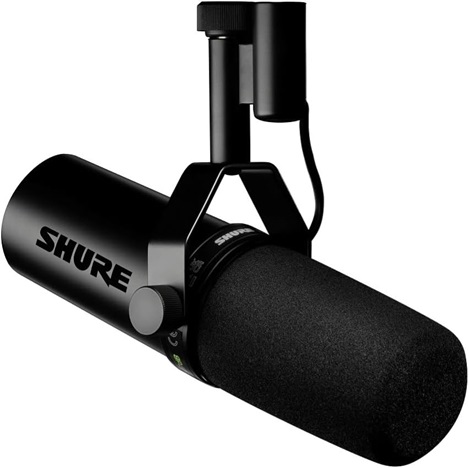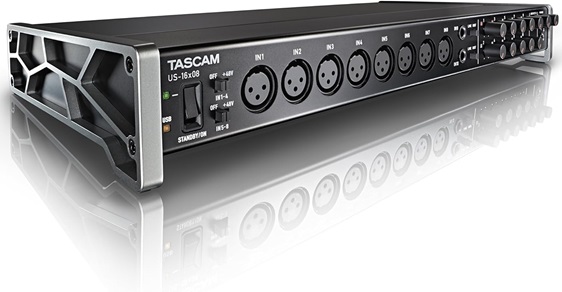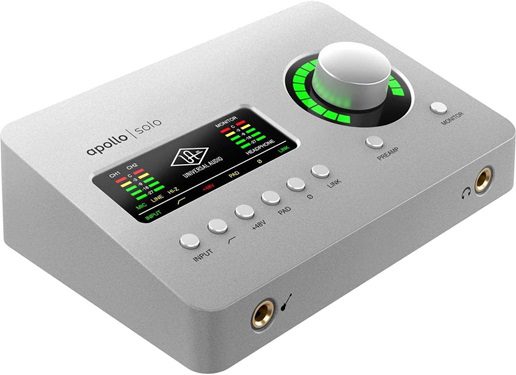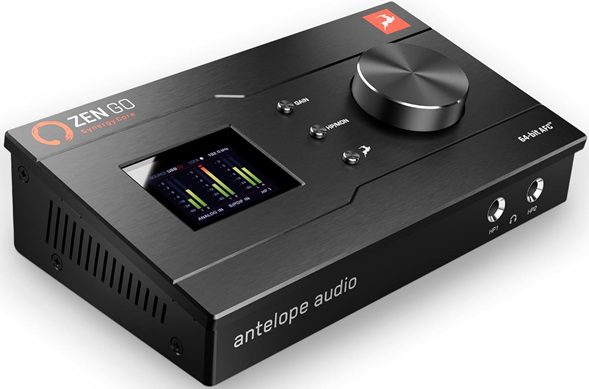An audio interface is an essential part of the equipment. It allows you to connect your microphones, instruments, and other audio devices to your computer so that you can record, edit, and mix your music. Audio interfaces come in a variety of shapes and sizes, with different features.
Some interfaces include built-in DSP (Digital Signal Processing) chips, which can add additional functionality, such as compression, reverb, and delay. DSP-enabled audio interfaces offer a range of advanced features, including onboard effects processing, channel expansion, and mixing capabilities, all without placing undue strain on the host computer’s CPU resources. This makes them ideal for both home studios and professional production environments.
- No of Channels: The number of channels, encompassing both inputs and outputs, opens up a world of possibilities, enabling you to effortlessly capture a diverse array of sound sources.
- Gain Rate: The gain rate is a fundamental feature, that empowers you with the precision required to finely adjust and optimize your audio signals, ensuring they are recorded with unmatched accuracy and clarity.
In this article, we provided the “Top Features” to consider while buying the audio interface with DSP. Choose the right one based on your needs.
Outline
ToggleBest Audio Interfaces With DSP Table
| Best Audio Interface with DSP | No. of channels | Gain Rate | Buy Now |
|---|---|---|---|
| Shure Audio Interface | 1 | 20dB | Check On Amazon |
| Tascam Audio Interface | 16 | 56dB | Check On Amazon |
| Antelope Audio Audio Interface | 6 | 127dB | Check On Amazon |
| PreSonus Audio Interface | 8 | 40 dB | Check On Amazon |
| Universal Audio Audio Interface | 2 | -- | Check On Amazon |
Best Audio Interfaces With DSP Reviews
1. Shure Audio Interface

The MVi has an easy touch panel that controls the volume, mute, and other settings with your fingers. It has a special input that makes your recordings sound clear. It can handle different recording situations because it has inputs for both microphones and instruments. This device helps you record great audio making your work even better.
Best Features:
- Supports XLR microphones and 1/4″ instruments for flexibility.
- Easily adjust sound settings for different recording needs.
- Simple touch panel for volume, mute, and gain adjustments.
- Fine-tune audio settings with iOS devices for precise control.
- Portable and versatile for on-the-go recording.
- JFET Class A preamplifier ensures exceptional tone and clarity.
- Combo XLR and 6.3 mm inputs accommodate various recording scenarios.
Pros:
- Streamlines audio adjustments with preset modes.
- Intuitive touch controls for quick and easy operation.
- Delivers high-quality sound with clear tones.
- Supports both microphones and instruments for versatility.
Cons:
- May require an iOS device for advanced manual settings.
2. Tascam Audio Interface

The US-16×08 works well with both Windows and Mac computers. It also provides strong power to all types of microphones making it work well with different microphones. It is a fantastic audio device. It has great sound, lots of cool features and it works well with different setups. It is perfect for music pros and fans who record and produce music.
Best Features:
- 16 channels of audio input and output
- 8 Ultra-HDDA microphone preamps
- Built-in DSP mixer for low-latency digital mixing
- Versatile standalone mic preamp mode
- Compatibility with Windows and Mac
- +48V phantom power for microphones
- Excellent audio quality
- Low-latency digital mixing
Pros:
- Versatile for various recording needs
- Compact and lightweight design
- Wide compatibility with different operating systems
- Phantom power for microphones ensures flexibility
Cons:
- Limited level control for monitoring on the front panel
3. Antelope Audio Audio Interface
The Antelope Audio Zen Go Synergy Core is a strong tool for recording sound. It has a clear and great sound. It is like having a fancy studio in a small device. It comes with 37 effects built-in, and you can add even more if you want. It can easily create top-notch voice recordings for podcasts, intros, and ads with clear vocals using the Zen Go Synergy Core. It works smoothly with both Mac and Windows devices and does not need an extra power source.
The simple panel has easy-to-use buttons, making it a breeze to monitor and record your audio. This small device gives you top-notch sound quality, perfect for using at home, recording on the go, or doing live streams. It comes with a dynamic range of 127dB sound and high-quality preamps for clear audio. It can plug in microphones, instruments, or other devices using the two combo XLR jacks. Enjoy clear sound quality with Antelope’s special 64-bit Acoustically Focused Clocking (AFC). It comes with over 20 years of Antelope Audio’s know-how in making digital audio sound better.
Best Features:
- Offers 127dB of headroom and 64-bit AFC technology for exceptional sound.
- Provides a variety of creative options for recording and mixing.
- Expands sound possibilities for added flexibility.
- Bunch of 37 special effects
- 50 extra features
- Portability and bus-powered design.
- Convenient and portable, requiring no external power source.
Pros:
- A wide range of built-in effects.
- Expandable with additional features.
Cons:
- May be relatively expensive.
4. PreSonus Audio Interface

Moreover, this device gives you 8 extra ways to connect things using ADAT Optical, which gives you even more choices for what you can plug in. The zero-latency monitor mixing lets you hear your recordings as you make them, without any delay. This makes recording and mixing smoother and easier. It also includes the Studio Magic Plug-in Suite, which is a cool set of computer tools and effects to make your creative work even better. It helps you record, make, and produce great-sounding audio with skill and quality.
Best Features:
- 18 input channels and 8 output channels
- 4 high-quality mic preamps
- ADAT Optical input expansion
- Zero-latency monitor mixing
- UC Surface software compatibility
- Included Studio Magic Plug-in Suite
Pros:
- Versatile with multiple input and output options
- Real-time monitoring without delay
- User-friendly software support
- Bonus software tools for creativity
Cons:
- Large and heavy, less portable than some alternatives.
5. Universal Audio Audio Interface

This device has two inputs for microphones or instruments, two outputs for connecting to other equipment, and a great headphone amplifier. It is not an interface; it is a complete audio solution.
Best Features:
- Replicates classic mic preamp sounds.
- Comes with LUNA Recording System and plug-ins.
- Captures music with clarity (24-bit/192 kHz).
- Bus-powered for on-the-go use.
- 2 combo inputs, 2-line outputs, and a headphone amp.
- Versatile connectivity options.
Pros:
- High-quality sound replication.
- Extensive plug-in and software bundle.
- Portable and bus-powered.
Cons:
- Pricey for beginners.
Buying Guide For The Best Audio Interfaces With DSP
1. No. of Channels
This Audio Interface with DSP determines the maximum number of microphones, instruments, or line-level sources you can simultaneously record or monitor. Home studios may suffice with a 2-channel or 4-channel interface, while professional studios often require interfaces with 8-channel or more channels. A versatile audio interface should offer a range of channel options, typically from 2 to 16 or more.
2. Gain Rate
The preamp gain rate is essential for achieving optimal audio quality. Look for an audio interface with adjustable gain settings, ensuring it accommodates different sources like microphones and instruments. A wide gain range enables precise control over input levels.
3. Connectivity Technology
Determine the connectivity technology that suits your setup. Common options include USB, Thunderbolt, FireWire, and Ethernet. Ensure that your computer or device is compatible with the chosen technology, as it affects data transfer speed and latency.
4. Phantom Power
If you intend to use condenser microphones, ensure the audio interface provides phantom power (typically 48V). Phantom power is necessary to power these types of microphones. Check whether it offers phantom power on all channels if you plan to use multiple condenser mics simultaneously.
5. Compatibility
Verify that the audio interface is compatible with your operating system (Windows, macOS, etc.) and digital audio workstation (DAW) software. It’s crucial that the interface seamlessly integrates with your existing setup for smooth recording and production workflows.
Audio Interfaces With DSP – FAQs
Ans: DSP, which stands for digital signal processing, serves as a method employed to enhance the sound quality in-car audio systems. It enables us to manage time alignment, crossovers, and equalizers for individual speakers in a car, leading to enhanced stereo imaging, an improved soundstage, and an overall upgrade in sound quality.
Ans: Digital signal processing (DSP) involves executing signal processing through digital methods, utilizing digital hardware and/or computing devices. While signal processing can also be done in the analog domain, there are several reasons why digital processing is often the preferred choice.
Ans: DSP is utilized in image processing for tasks like image enhancement and recognition. In control systems, DSP helps analyze and manipulate signals for applications like motor control and automation. In audio, DSP is employed for tasks such as equalization, filtering, and compression to enhance sound quality.
Conclusion
In conclusion, when exploring the realm of audio interfaces with DSP capabilities, it’s essential to consider your unique requirements and preferences. Among the top contenders in this category, three standout options have consistently proven to deliver exceptional performance and versatility.
- Shure Audio Interface: Known for its impeccable sound quality and reliable build, the Shure Audio Interface offers a comprehensive DSP suite, empowering users with real-time processing and pristine audio. It’s an excellent choice for those seeking a balance between quality and affordability.
- Antelope Audio Interface: Renowned for its cutting-edge DSP technology and meticulous audio processing, the Antelope Audio Interface is a top-tier choice for professionals and enthusiasts. Its wide array of features and exceptional sound quality make it a standout option.
- Universal Audio Audio Interface: Universal Audio Interface has long been an industry leader in DSP-powered audio interfaces. Their products are favored by many audio professionals due to their superb DSP effects, extensive plugin library, and robust build quality. While it’s a premium choice, the investment is well worth it for those seeking top-tier performance.
Ultimately, the best audio interface with DSP for you will depend on your specific needs, budget, and workflow. Each of these options has its strengths, so carefully consider your requirements and choose the one that aligns most closely with your recording and production goals.


